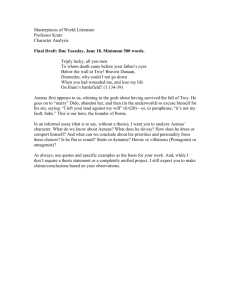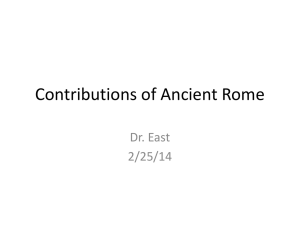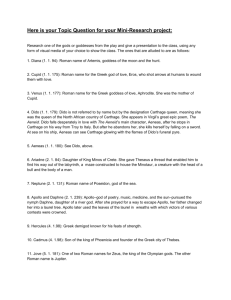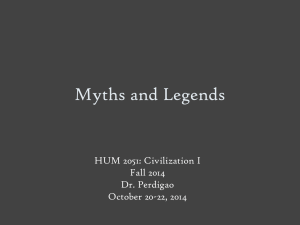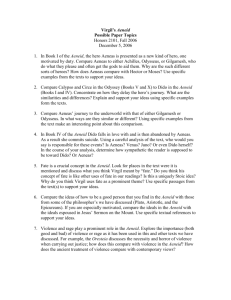Set text guide - Virgil activity - Handbook (DOCX, 201KB) New 18/04/2016
advertisement
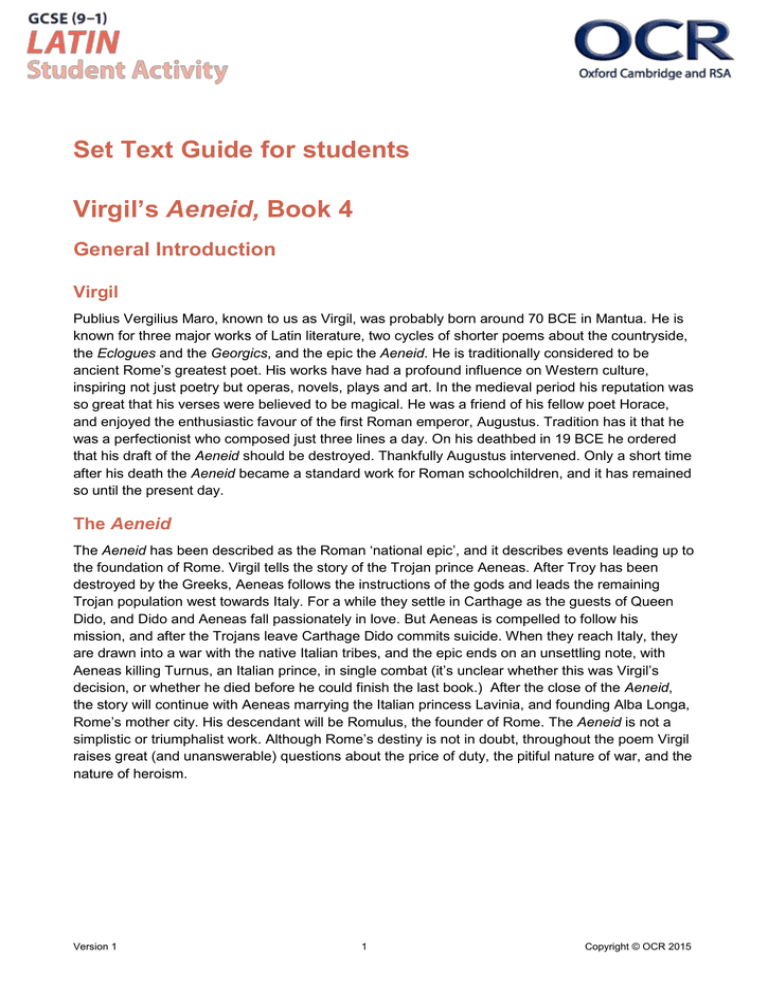
Set Text Guide for students Virgil’s Aeneid, Book 4 General Introduction Virgil Publius Vergilius Maro, known to us as Virgil, was probably born around 70 BCE in Mantua. He is known for three major works of Latin literature, two cycles of shorter poems about the countryside, the Eclogues and the Georgics, and the epic the Aeneid. He is traditionally considered to be ancient Rome’s greatest poet. His works have had a profound influence on Western culture, inspiring not just poetry but operas, novels, plays and art. In the medieval period his reputation was so great that his verses were believed to be magical. He was a friend of his fellow poet Horace, and enjoyed the enthusiastic favour of the first Roman emperor, Augustus. Tradition has it that he was a perfectionist who composed just three lines a day. On his deathbed in 19 BCE he ordered that his draft of the Aeneid should be destroyed. Thankfully Augustus intervened. Only a short time after his death the Aeneid became a standard work for Roman schoolchildren, and it has remained so until the present day. The Aeneid The Aeneid has been described as the Roman ‘national epic’, and it describes events leading up to the foundation of Rome. Virgil tells the story of the Trojan prince Aeneas. After Troy has been destroyed by the Greeks, Aeneas follows the instructions of the gods and leads the remaining Trojan population west towards Italy. For a while they settle in Carthage as the guests of Queen Dido, and Dido and Aeneas fall passionately in love. But Aeneas is compelled to follow his mission, and after the Trojans leave Carthage Dido commits suicide. When they reach Italy, they are drawn into a war with the native Italian tribes, and the epic ends on an unsettling note, with Aeneas killing Turnus, an Italian prince, in single combat (it’s unclear whether this was Virgil’s decision, or whether he died before he could finish the last book.) After the close of the Aeneid, the story will continue with Aeneas marrying the Italian princess Lavinia, and founding Alba Longa, Rome’s mother city. His descendant will be Romulus, the founder of Rome. The Aeneid is not a simplistic or triumphalist work. Although Rome’s destiny is not in doubt, throughout the poem Virgil raises great (and unanswerable) questions about the price of duty, the pitiful nature of war, and the nature of heroism. Version 1 1 Copyright © OCR 2015 Epic The Aeneid is the major Latin work surviving in the genre of Epic, although there are others, mostly less well-known. An epic is a lengthy narrative poem with a serious subject: usually mythological or in some sense historical, or (as with the Aeneid) an apparent blend of the two. Virgil was inspired by the Greek epics of Homer, the Iliad and the Odyssey; both were well known to Greeks and Romans throughout the Classical age. Aeneas’ voyage from Troy in the first half of the Aeneid parallels that of Odysseus, who journeys home from the Trojan War to his kingdom on Ithaca: the difference is that Aeneas is not going back, but going to a new home. The second half is more closely inspired by the Iliad, as the Trojans fight an epic war in Italy against the Italian tribes. Ancient epic was intended to be read aloud and recited, and so Virgil pays close attentions to the sounds of his Latin. He uses a metre (a set poetic rhythmic framework) called dactylic hexameter, typical of epic. He can carefully manipulate this framework so as to make specific effects of sound and rhythm. Talking Points Talking Point Notes What epics are known to us from other cultures? What might be the equivalent of epic writing today? What does it mean to be ‘inspired by’ another author’s work? Does this make the later work unoriginal? Version 1 2 Copyright © OCR 2016 Context The Age of Augustus Virgil lived through one of the worst periods of Civil War in Rome’s history, when rival generals tore apart the Republican system of government in their pursuit of power. Nearly every family in Italy was drawn into the conflict in some way, and countless young men were killed by their fellowcitizens. In 31 BCE – as Virgil was about to turn 40 – Julius Caesar’s great nephew, Gaius Julius Caesar Octavianus (known to us as Octavian) defeated his enemy Mark Antony, and so was the last general standing. He took the new name Augustus, and became the first Roman emperor. Augustus reigned for thirty years, during which time Rome was rebuilt and recovered from the damage of civil war. In order to reinforce his own position and the era of peace, Augustus used traditional myths and legends as a way of uniting the Roman people. The Trojan hero Aeneas was well known before Virgil’s epic; he was believed to be a member of the Julian family and therefore an ancestor of Augustus and his great-uncle Julius Caesar. Because the Aeneid’s content chimes so closely with the cultural programme promoted by Augustus, it has sometimes unfairly been described as Augustan propaganda. Antony and Cleopatra Augustus’ rival in the Civil Wars, Marcus Antonius, or Mark Antony, had formed an alliance with the powerful Queen of Egypt, Cleopatra VII and with her had had three children. After their defeat at the Battle of Actium both Antony and Cleopatra committed suicide. Augustus’ propaganda portrayed Cleopatra as an out-of-control witch who had ensnared Antony. She was turned into a symbol of everything the Romans feared: a barbarian enemy, a woman who didn’t know her place. Thus a bloody conflict between Romans - a civil war - could be portrayed instead as a war between Rome and Egypt, and more broadly West and East. Many scholars have seen in Virgil’s characterisation of Dido a reference to Cleopatra, another ‘barbarian’ queen from North Africa. Unlike Antony, however, Aeneas does not forget his duty to Rome. Rome and Carthage Dido’s city, Carthage, would have been well known to Virgil’s audience. Although Virgil made up many new aspects of the story, he was building on the traditional account of Carthage’s history that began with the arrival of Queen Dido (also known as Elissa or Alissar) with her people from modern-day Lebanon around 814BCE. According to legend, she had left her home land following the death of her husband, Sychaeus (also known as Acerbas), at the hands of her own brother. There had later been a long and bitter struggle between Rome and Carthage for control of the whole Western Mediterranean. The popularity of Cato the Elder’s famous utterance, ‘Carthago delenda est’, ‘Carthage must be destroyed’, illustrates the legendary status of this city, so troublesome to the Romans. The three rounds of Punic Wars between Rome and Carthage spanned over a century, ending in the final defeat of Carthage in 146BCE. Version 1 3 Copyright © OCR 2016 And yet, by Virgil’s time, a brand new Roman colony had grown up where Carthage used to be. By the First Century AD, the new Carthage was the second-largest city in the Western Roman empire. The relationship between Rome and Carthage would never be a simple one! Virgil lived through one of the worst periods of Civil War in Rome’s history, when rival generals tore apart the Republican system of government in their pursuit of power. Nearly every family in Italy was drawn into the conflict in some way, and countless young men were killed by their fellowcitizens. In 31 BCE – as Virgil was about to turn 40 – Julius Caesar’s great nephew, Gaius Julius Caesar Octavianus (known to us as Octavian) defeated his enemy Mark Antony, and so was the last general standing. He took the new name Augustus, and became the first Roman emperor. Augustus reigned for thirty years, during which time Rome was rebuilt and recovered from the damage of civil war. In order to reinforce his own position and the era of peace, Augustus used traditional myths and legends as a way of uniting the Roman people. The Trojan hero Aeneas was well known before Virgil’s epic; he was believed to be a member of the Julian family and therefore an ancestor of Augustus and his great-uncle Julius Caesar. Because the Aeneid’s content chimes so closely with the cultural programme promoted by Augustus, it has sometimes unfairly been described as Augustan propaganda. Version 1 4 Copyright © OCR 2016 Talking points Talking Point Notes Antony and Cleopatra: Augustus manipulated the public perception of events and characters to make the public believe that Cleopatra was the villain. “Propaganda” is a term for information, generally regarded to be false or at least misleading, that is spread to promote a particular idea or viewpoint. What examples of propaganda can we find in history? Can propaganda be seen in use around us today? Rome and Carthage: What similar rivalries and power struggles between cultures and civilisations have shaped the history of the world, historically and today? East meets West: it is tempting to think of Roman and Greek culture as fundamentally Western, fundamentally different from Eastern cultures such as Dido’s. But does this stand up to scrutiny? Version 1 5 Copyright © OCR 2016 The Text Context of prescribed sections - Aeneas and Dido The section of the Aeneid you will be reading deals with Aeneas’ relationship with Dido, the Queen of Carthage. Like Aeneas, Dido is an exile: her people are originally from Asia, but after her husband Sychaeus was murdered by her own brother, she has come with her people to North Africa to build a new city. Since the Trojans’ arrival, Dido (under the influence of the goddess Venus) has fallen desperately in love with Aeneas. Virgil describes her as ‘suffering from love’s deadly wound.’ The early part of Book 4 powerfully portrays her anguish at renouncing the vow she had made, after Sychaeus’ death, not to take another husband. Aeneas returns her love and Dido renounces her vow, becoming convinced in her own mind that they have been married by the gods themselves. Aeneas helps Dido in building the new city. However, at Jupiter’s command, Mercury, the messenger of the gods, visits Aeneas to remind him of his mission to travel to Italy and found Rome. Aeneas can’t bring himself to tell Dido that the Trojans are preparing to leave, but she discovers the truth and confronts him. As the Trojan ships sail away, Dido commits suicide, climbing onto a funeral pyre and falling on Aeneas’ sword. Two books later, the Trojans have reached Italy and the town of Cumae, the home of the prophetess known as the Sibyl. He journeys into the underworld, and sees Dido’s ghost; she refuses to speak to him, and disappears. Prescribed sections - Aeneid 4.279-319, 331-361, 381-396 and 6.450-476. Prior to the prescribed section, Mercury has visited Aeneas and reminded him that his god-given mission is to found a new Troy. He must leave Dido and Carthage, and sail on towards Italy. 4.279-319 Aeneas, concerned by what Mercury has said to him, ponders how to tell Dido that he must leave. He orders his men to prepare the fleet and goes to see Dido. She, having already worked out what he is going to say, becomes very emotional and accuses him of deception; she begs him to change his mind. 331-361 Aeneas responds to Dido, explaining the duty that he feels, and that the gods themselves have specifically commanded him to move on. 381-396 Dido responds, telling Aeneas to go; she promises that he will suffer and be punished, and that she will haunt him even after her death. She leaves and collapses in her chamber. Aeneas, heavily affected, departs from Carthage with his people. 6.450-476 Version 1 6 Copyright © OCR 2016 Aeneas, much further on in his voyage, is visiting the underworld. Here he sees the ghost of Dido, and realising that she has died, he addresses her and again tries to explain how his duty led him away from her. She, however, makes no reply and disappears amongst the spirits of the dead, leaving Aeneas to weep for her. Themes and Motifs Pietas – Virgil gives Aeneas the epithet ‘pius’. This is a difficult word to translate into English, but means something a bit like ‘dutiful to a higher cause’. In Book 4, Aeneas’s duty - to his mission and the will of the –gods - forces him to abandon Dido, and some have suggested that Dido’s principal role in the story is to illustrate the ‘pietas’ of Aeneas. Love and fidelity - Dido’s love for Aeneas is overshadowed by her marriage to Sychaeus that ended so brutally. Early in Book 1 she confides to her sister Anna that she has sworn a vow never to remarry, but her feelings for Aeneas have caused her to overcome her resolve. This makes us aware that Dido has made a permanent sacrifice to “marry” Aeneas, which raises the stakes in their relationship. Is Aeneas’s sacrifice equal to Dido’s? A clash of civilisations - The meeting, union and later hostility between Rome and Carthage underpins the story, and would have had great resonance with Virgil’s Roman audience. Virgil seems to imply that the Punic Wars were the climax of an enmity dating back to these mythical times, and that the gods were to blame - at least in part. Literary Features Virgil’s writing is rich in detail, imagination and skill: what is at heart a very straightforward plot becomes a powerful, emotional, detailed and thought-provoking story in which many things are not as simple as they seem. Virgil’s writing is rich in detail, imagination and skill: what is at heart a very straightforward plot becomes a powerful, emotional, detailed and thought-provoking story in which many things are not as simple as they seem. Version 1 7 Copyright © OCR 2016 Here is a simple technique for finding out what is special about a piece of writing yourself. Ask: ‘what is the simplest way that the author could have conveyed this information, and how has the author chosen to write instead?’ For example, in lines 279-80: At vero Aeneas aspectu obmutuit amens, arrectaeque horrore comae et vox faucibus haesit. Here Virgil could have conveyed the information very simply: Aeneas aspectu obmutuit. (‘Aeneas fell silent at the sight.’) But instead, he tells us about Aeneas’s psychological state (amens, ‘out of his mind’); he focuses on the physical symptoms of Aeneas’s reaction (arrectae horrore comae, ‘his hair stood on end in horror’); and he gives a metaphor to emphasise these symptoms (vox faucibus haesit, ‘his voice clung to his jaws’). Stylistic Features This brief list introduces you to just some of the ways that Virgil crafts his poetry. Many of the points to be made will involve one of the three main features given here. Whenever you think about a poet’s style you should ask yourself why the poet might choose to use a particular technique: the technique is only interesting if you can explain how it enhances the meaning. Choice of vocabulary What is the difference between ‘upset’, ‘out of his/her mind’, and ‘raging’? And between ‘surprise’, ‘fright’ and ‘horror’? Why do you think Virgil used specifically ‘amens’ and ‘horror’ in the passage above? A skilled poet such as Virgil could find a way to use almost any word they wished; we can ask ourselves why exactly that word was chosen. Word order As you know, the order of words in Latin is much more free than in English. Virgil is usually free to choose which word comes first in each line and each phrase, for example. The audience will latch on to the first word that they hear; we can say that this is an ‘emphatic position’. So, in line 281, ‘ardet’ (‘he burns with desire’) is given emphasis, coming first where we would expect the verb to come last. The last word in a line, or the last word in a phrase, is also significant because it stays in the audience’s mind for a moment before the next line or phrase begins. For example, in line 282, ‘deorum’ (‘of the gods’) lingers at the end of the line, putting focus on how important the command must be if it comes from the gods. Version 1 8 Copyright © OCR 2016 Repetition Many poetic effects (including alliteration and assonance) rely on repeating something: a sound, a word, or an idea. Repetition reinforces the idea behind the words, and sometimes literally ‘acts out’ the thoughts of a character. For example, in lines 283-4, Virgil repeats the idea of Aeneas asking himself a question; there are three question-words (‘quid?... quo?... quae?’, ‘what?... with what?... which?’ and the effect is to portray Aeneas’s anxiety. Glossary of Key Terms Now over to you. Key terms regarding content and literary techniques. Now find your own examples of these techniques and list them in the boxes below. Anaphora - a repeated structure E.g. 4.285: “nunc huc... nunc illuc”, where the repeated “nunc” (“now”) emphasises how Aeneas’s disturbed thoughts turn “now this way, and now that way” as he tries to decide what to do. Metaphor - a description of one thing as if it were something else that it is not literally the same as. Often very like a simile, except there will be no word for “just like” or “as if” E.g. 4.280: “vox faucibus haesit”, where Aeneas’s voice did not literally cling to his jaws, but the image that the words create gives a strong impression of how difficult it was for him to speak. Pathos - the use of strong emotion (usually sadness!) E.g. 4.390, where Dido’s physical collapse (“conlapsaque membra”) and the image of her left alone on her marble bed, a symbol of her power and wealth (“marmoreo... thalamo”), make for a moment of great sadness. Simile – a description of one thing that compares it directly to another thing (introduced by a word that means “just like” or “as if”). Especially common in Virgil are similes that compare a person under high emotion to an animal E.g. 4.301: “(bacchatur) qualis... Cithaeron”, where Dido rages “just like” a Bacchant. Version 1 9 Copyright © OCR 2016 Tricolon - a set of three items (often with anaphora, forming an “anaphoric tricolon”). E.g. 4.283-4: “quid...? quo...? quae...?”, where the set of three questions (“What? Where to? What?”) shows Aeneas’s turmoil and indecision. Talking points Talking Point Notes Pietas: does Aeneas make a good choice? Is there a “right” option open to him? Dido’s reaction: can we sympathise with Dido? Is she right to react to Aeneas as she does? A clash of civilisations: what questions about their history and culture might occur to Virgil’s Roman audience when they hear this story unfold? Version 1 10 Copyright © OCR 2016 Talking Point Notes Stylistic writing: consider the wide range of Virgil’s techniques. Which of these are still in use today? Can you think of any famous examples of these techniques in action? Activities and tasks Roman poetry read aloud Classical Language Instruction Project, Princeton University http://www.princeton.edu/%7Eclip/ Listen to recordings of Roman poetry (including the opening of the Aeneid) Exploring the metre and techniques of Virgil’s poetry Cambridge Schools Classics Project http://www.cambridgescp.com/Upage.php?p=cla^verse1^v_stage59&view_section=1#section1 Explore the sound and metre of Roman poetry, including by learning to scan the dactylic hexameter; explore also the literary terms and devices that Roman poets used. Discovering Augustus The Classics Pages http://www.the-romans.co.uk/augustus.htm Learn about the story of the whole Aeneid in an accessible summary. Also on this website are translations of the whole of Books 4 and 6, and of Book 1 which includes Dido and Aeneas’s first meeting. Version 1 11 Copyright © OCR 2016 Task 1: Storyboarding Create a film storyboard for the first section of your set text (4.279-319), make sure that all aspects of the Virgil’s story would be clear to an audience watching your film. Version 1 12 Copyright © OCR 2016 Task 2: Dido’s Court Case Lawyer Representing: Claim Evidence Notes My Verdict: Class Verdict: Reasons: Version 1 13 Copyright © OCR 2016 For students Extensive further reading is available at http://www.cambridgescp.com/Upage.php?p=cla^verse1^v_stage59&view_section=1#section1 We’d like to know your view on the resources we produce. By clicking on ‘Like’ or ‘Dislike’ you can help us to ensure that our resources work for you. When the email template pops up please add additional comments if you wish and then just click ‘Send’. Thank you. If you do not currently offer this OCR qualification but would like to do so, please complete the Expression of Interest Form which can be found here: www.ocr.org.uk/expression-of-interest OCR Resources: the small print OCR’s resources are provided to support the teaching of OCR specifications, but in no way constitute an endorsed teaching method that is required by the Board, and the decision to use them lies with the individual teacher. Whilst every effort is made to ensure the accuracy of the content, OCR cannot be held responsible for any errors or omissions within these resources. © OCR 2016 - This resource may be freely copied and distributed, as long as the OCR logo and this message remain intact and OCR is acknowledged as the originator of this work. OCR acknowledges the use of the following content: n/a Please get in touch if you want to discuss the accessibility of resources we offer to support delivery of our qualifications: resources.feedback@ocr.org.uk Version 1 14 Copyright © OCR 2016
